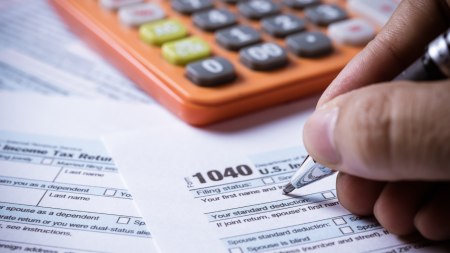Credit card interest rates are too damn high, according to an unlikely combination of politicians who’ve recently drawn attention to the subject.
Money experts agree credit card debt can be a major challenge for many card users. At 20.1 percent, the average credit card interest rate imposes a steep penalty in the form of interest charges for people who carry debt on their cards.
President Donald Trump talked about capping credit card interest rates on the campaign trail in the fall of 2024. And now a recent bill introduced in Congress proposes to turn that campaign promise into law. Senators Bernie Sanders, I-Vt., and Josh Hawley, R-Mo., recently proposed legislation that would cap credit card interest rates at 10 percent for five years after the bill is enacted.
It’s worth taking notice when politicians from complete opposite sides of the aisle agree on something that has potential to make a big impact for millions of Americans. But is such a cap even possible — and if so, how would it really affect consumers?
I recently spoke to Chi Chi Wu, senior attorney at the National Consumer Law Center, and Ted Rossman, senior industry analyst at Bankrate, to get some expert insight as well as advice on how to deal with high card rates, regardless of whether the bill passes.
Is the 10 percent credit card interest rate cap even possible?
To answer simply, a 10 percent cap on credit card interest rates is possible. Whether this bill (or any other bill for that matter) has any fighting chance, however, is a different matter.
“The cap is possible if Congress acts,” Rossman says. “But I don’t think this will pass. The financial lobby is strong, and there would be major unintended consequences for consumers.”
Getting laws passed that help consumers has always been a struggle, says Wu, who has been a consumer advocate for 20 years.
“There have been so many good and important bills to limit interest rates over the years that have just gotten nowhere,” she says.
For example, the Veterans and Consumers Fair Credit Act, introduced in 2021, would have established a 36-percent interest rate cap on consumer loans. The proposed legislation didn’t gain any traction.
Hawley has proposed a cap on card rates in the past. The Capping Credit Card Interest Rates Act would have capped card interest rates at 18 percent, including all finance charges. That bill also didn’t go anywhere.
“Nonetheless, it’s notable that these conversations are happening and there seems to be a growing appetite for change on both sides of the political aisle,” Rossman says. “How often do Donald Trump and Bernie Sanders agree on policy proposals?”
How the 10% interest rate cap could affect you
Such a low cap on credit card interest rates has the potential to have major consequences for the industry — as well as for you as the consumer.
Easing the card debt burden
Almost half (48 percent) of credit cardholders have a credit card balance, as of November 2024, according to Bankrate’s Credit Card Debt Survey. If you’re one of them, you probably know how your card’s interest rate makes it all the harder to get rid of the debt.
A 10-percent cap could certainly make a difference. Consider this: the average credit card balance was $6,730 in 2024, according to Experian. If you paid $200 per month at a 20 percent interest rate, it would take you 50 months to pay off the debt. You’d also pay $3,254 in interest charges. On the other hand, if your interest rate was only 10 percent, you’d pay off the balance in 40 months, including $1,201 in interest.
As you can see, the difference is significant. If the bill passes, millions of Americans could feel relief from their credit card debt burden.
However, that’s not likely to be the only impact this legislation will have.
Potential higher fees
It’s no secret that credit card companies make money on interest. And if that source of profit is diminished, they won’t just absorb the loss. They’ll look for ways to recoup it.
Namely, your interest rate isn’t the only thing to consider when you think about the cost of your credit card debt. There are also fees.
“You could have a credit card with a 10 percent interest rate or a 0 percent interest rate,” Wu says. “But [if] there are a huge amount of fees associated with it, it’s still going to cost you a lot of money.”
Such fees could include higher annual fees, monthly fees, participation fees or program fees. Many of these are mostly present on certain credit cards for bad credit, but there’s no reason credit cards from major issuers can’t charge them, Wu says.
The Sanders-Hawley bill to cap card interest rates at 10 percent doesn’t have the text available, so there’s no saying whether it will include measures to prevent issuers from imposing excessive fees to salvage their bottom line.
Limited access to credit
Credit card issuers determine your interest rate based on your credit profile, among other things. A higher interest rate serves as a protective measure in case you default on your debt — which isn’t profitable for the issuer. For that reason, if you’re new to credit or your credit history isn’t perfect, your credit card interest rate can be higher. This way, the issuer exercises caution when lending to you.
Now, imagine if the issuer can’t do that anymore. Instead of taking on the lending risk, it’s more likely to deny your credit application altogether.
And that’s how the proposed legislation might lead to another unintended consequence: people with limited or poor credit history losing access to credit. For Americans who depend on it for help with daily expenses or to pay for unexpected emergencies, such a development could push them to seek even riskier options. For instance, payday loans require no credit check but tend to come with a triple-digit APR and aggressive repayment terms.
Changes to benefits and rewards programs
Credit card issuers offer valuable benefits and card rewards to attract and retain customers. It works. Almost three in four Americans (71 percent) say they have a credit card that offers rewards, according to the Ipsos Consumer Tracker. And eight out of 10 of them (80 percent) value the rewards they get.
If an issuer’s bottom line is impacted by reduced profits from interest charges, benefits and rewards could be sacrificed to make up for the losses. We can only speculate what such sacrifices would look like, but to cardholders who use cards solely for rewards, this would be sad news either way.
What you can do about your high interest rate right now
Regardless of what happens with the bill, it’s always wise to prioritize getting rid of expensive debt.
“My best advice is to take matters into your own hands to pay down your debt,” Rossman says.
Here are a few things you can do:
- Use tools to lower your interest rate. For example, if you have good or excellent credit, you can move your balances to a balance transfer card to get 0 percent interest on them for the length of the intro period. Some of our favorite cards offer as long as 21 months of no interest on balanced transfers. Alternatively, you can convert your credit card debt into a personal loan with a lower interest rate.
- Look into credit union credit cards. “Credit unions are a good alternative,” Wu says, explaining that by law, federal credit unions can’t charge their members card rates exceeding 18 percent.
- Focus on paying down your debt. From choosing a repayment method to committing to debt consolidation, there are many solutions you can pick from. The key is to stick with it.
- Work with a credit counselor. If you’re overwhelmed by credit card debt and struggling to find a solution on your own, consider working with a reputable nonprofit credit counseling agency. A credit counselor can evaluate your situation and make recommendations to help you get rid of debt.
The bottom line
The 10 percent credit card interest rate cap could help countless Americans battling with credit card debt. At the same time, it could also lead to unknown and potentially negative consequences, such as limited access to credit, higher card fees and reduced rewards and benefits.
Whatever happens to this proposed legislation, make it your financial goal to bring down your credit card debt. After all, your interest rate doesn’t matter much when your card balance is $0.
Read the full article here










